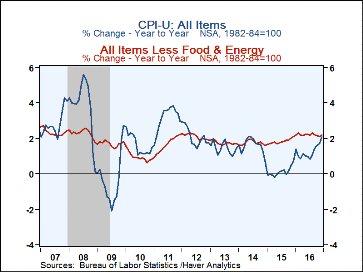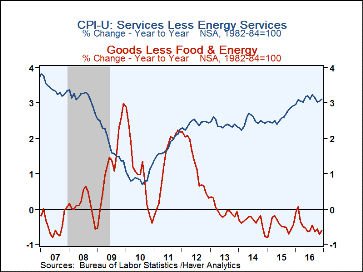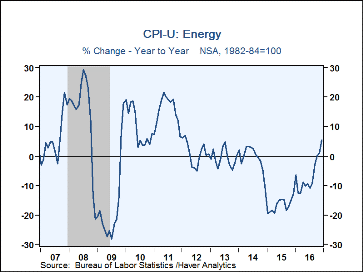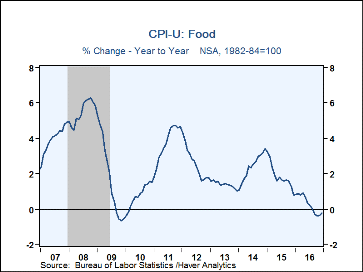 Global| Jan 18 2017
Global| Jan 18 2017U.S. CPI Registers Faster Growth in 2016
by:Tom Moeller
|in:Economy in Brief
Summary
The Consumer Price Index during all of 2016 increased 2.1% from December-to-December, the quickest y/y gain since June 2014. The 2.2% advance in prices excluding food & energy compared to a 2.1% rise in 2015. During December alone, [...]
The Consumer Price Index during all of 2016 increased 2.1% from December-to-December, the quickest y/y gain since June 2014. The 2.2% advance in prices excluding food & energy compared to a 2.1% rise in 2015. During December alone, the CPI increased 0.3% following a 0.2% November gain. The rise equaled expectations in the Action Economic Forecast Survey. Prices excluding food & energy rose a stable 0.2%, as expected.
Higher energy prices led the pick-up in inflation last year with a 5.4% y/y increase, and 1.5% in December alone. Gasoline prices increased 3.0% (9.1% y/y) during December, and during the year made up most of the decline in 2015. Fuel oil prices spiked 6.0% (NSA) in December. The 12.7% y/y rise was the strongest increase in five years. Natural gas prices eased 0.4% for a second straight month, but y/y prices rose 7.8% y/y following a 14.9% decline in 2015. Electricity costs remained unchanged m/m, and rose 0.7% y/y.
Prices for services provided another area of strength with a 3.1% y/y increase, up from 2.6% during all of 2015. The 3.6% y/y rise in shelter prices accelerated, compared to price deflation in 2010. Owners' equivalent rent of residences rose 3.6% y/y and rents of primary residences advanced 3.6% y/y. Medical care prices inched 0.1% higher last month, but the 3.9% y/y gain accelerated from 2.9% in 2015. Recreation services prices strengthened 2.9% y/y after a 2.5% rise in 2015. Education & communication prices were fairly stable y/y, and public transportation costs fell 2.3% last year following a 1.0% decline in 2014.
Heightened competition kept inflation in the goods-producing sector under wraps last year. Prices for goods excluding food & energy eased 0.6% y/y, and have been falling since 2012. Home furnishing prices declined 2.2% y/y, down nearly 10.0% since 2010. Appliance prices fell 4.4% y/y and have been working lower since 2009. Apparel prices dropped 0.7% last month, about as they did in November. They eased 0.1% y/y for a second yearly decline. Recreation product prices were off 3.5% y/y, continuing the price deflation in place for several years. New vehicle prices remained little changed all year, but medical care goods prices surged 4.7% during the year.
Declining food prices added to last year's price weakness. They were little changed during the last three months, and slightly lower y/y. Meat prices eased slightly during the last four months and moved 4.2% lower during the year. Egg prices declined by more than one-third versus December 2015; and dairy product prices fell 1.3%, continuing the price deflation of 2015. Fruit & vegetable prices fell 2.4% y/y, and cereal prices eased 0.7% y/y.
The consumer price data is available in Haver's USECON database while detailed figures can be found in CPIDATA. The expectations figure is from Action Economics and is found in the AS1REPNA database.
The Goals of Monetary Policy and How We Pursue Them is the title of today's speech by Fed Chair Janet L. Yellen, and it is available here.
| Consumer Price Index, All Urban Consumers (%) | Dec | Nov | Oct | Dec Y/Y | 2016 | 2015 | 2014 |
|---|---|---|---|---|---|---|---|
| Total | 0.3 | 0.2 | 0.4 | 2.1 | 1.3 | 0.1 | 1.6 |
| Total less Food & Energy | 0.2 | 0.2 | 0.1 | 2.2 | 2.2 | 1.8 | 1.7 |
| Goods less Food & Energy | 0.0 | -0.3 | 0.1 | -0.6 | -0.5 | -0.5 | -0.3 |
| Services less Energy | 0.3 | 0.3 | 0.2 | 3.1 | 3.1 | 2.6 | 2.5 |
| Food | -0.0 | -0.0 | -0.0 | -0.2 | 0.3 | 1.9 | 2.4 |
| Energy | 1.5 | 1.2 | 3.5 | 5.4 | -6.6 | -16.7 | -0.3 |
Tom Moeller
AuthorMore in Author Profile »Prior to joining Haver Analytics in 2000, Mr. Moeller worked as the Economist at Chancellor Capital Management from 1985 to 1999. There, he developed comprehensive economic forecasts and interpreted economic data for equity and fixed income portfolio managers. Also at Chancellor, Mr. Moeller worked as an equity analyst and was responsible for researching and rating companies in the economically sensitive automobile and housing industries for investment in Chancellor’s equity portfolio. Prior to joining Chancellor, Mr. Moeller was an Economist at Citibank from 1979 to 1984. He also analyzed pricing behavior in the metals industry for the Council on Wage and Price Stability in Washington, D.C. In 1999, Mr. Moeller received the award for most accurate forecast from the Forecasters' Club of New York. From 1990 to 1992 he was President of the New York Association for Business Economists. Mr. Moeller earned an M.B.A. in Finance from Fordham University, where he graduated in 1987. He holds a Bachelor of Arts in Economics from George Washington University.










